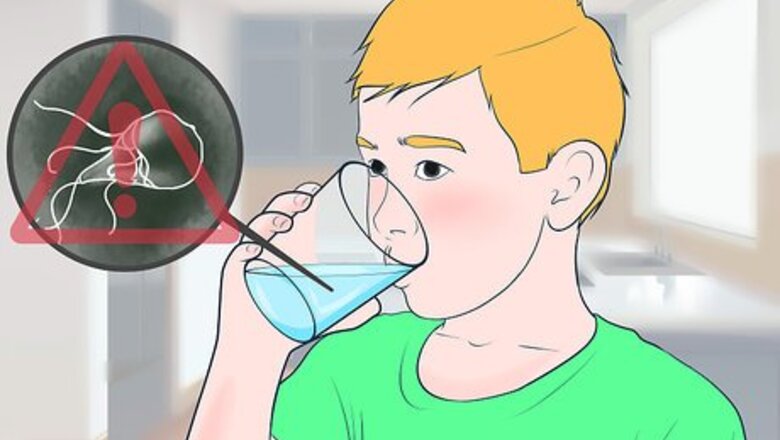
views
X
Trustworthy Source
Mayo Clinic
Educational website from one of the world's leading hospitals
Go to source
Unfortunately, the Giardia lamblia parasite that causes giardiasis can be present in any body of water, including streams, lakes, pools, spas, and even the water supply. Research suggests that medication may help shorten your recovery, which normally takes 2 to 6 weeks, so it's best to see a doctor if you suspect you have giardiasis.[2]
X
Trustworthy Source
Centers for Disease Control and Prevention
Main public health institute for the US, run by the Dept. of Health and Human Services
Go to source
Recognizing Symptoms

Consider if you may have been exposed to Giardia parasites. The way to determine if you have giardiasis is to combine your knowledge of your past behavior with your current symptoms and testing from your physician. Your risk of developing giardiasis increases if you or a family member member have been exposed to any of the following possible means for passing on the infection: You've been traveling overseas or have come into contact with international travelers, particularly in close quarters. You've had contaminated water, such as drinking water or ice made from contaminated sources like roof rainwater, rivers, streams, shallow wells, etc. contaminated by infected animals or people. Alternatively, you've had untreated (non-boiled) or unfiltered water. You've had contaminated food – this can be caused by someone handling food who hasn't washed their hands after changing a diaper or going to the toilet. You've been in contact with infected people, such as caregivers or family members of infected people. You've been exposed to feces through sexual contact. You haven't washed your hands after touching animals or infected people. You have or had contact with children who use diapers and/or with children spending time in a daycare setting. You have gone hiking and been exposed to untreated sources of water.
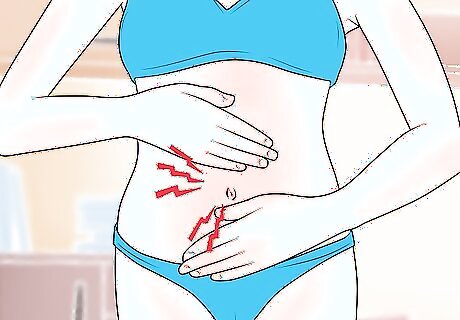
Look for physical symptoms of giardiasis. The symptoms of a Giardia infection can be non-specific. In other words, they can also mimic the symptoms of other intestinal disorders or infections. Symptoms of the infection will usually appear between one and two weeks after exposure. This is called the incubation period, or the time it takes for the parasite to cause symptoms to occur. The most obvious signs of infection are a number of gastrointestinal symptoms, including: Acute or chronic diarrhea with foul-smelling stool. With a Giardia infection, the stool can have a greasy appearance and blood is very rarely seen. You may find that the diarrhea alternates between watery stool and greasy, foul-smelling stool that floats in the toilet water. Abdominal cramps or pain Bloating Flatulence or passing much more gas than you normally do (the abdomen may be swollen from the gas in the intestines). Often the bloating, pain, and flatulence will all occur together. Nausea and vomiting Loss of appetite Belching gas with a very bad taste

Check for secondary symptoms related to the primary symptoms. The result of the diarrhea and other abdominal symptoms can trigger the following additional symptoms of a Giardia infection: Weight loss Dehydration Fatigue Low-grade fever or a fever less than 100.5 °F (38.1 °C) Individuals over the age of 60 often display symptoms that include anemia, weight loss and loss of appetite The very elderly and the very young can both be at particular risk for complications stemming from these secondary symptoms

Be aware that symptoms can change or even be absent. You may experience symptoms and then get better or you may experience a course of the illness in which you have symptoms, get better, and then feel badly again over several weeks or months. Some people who are infected with Giardia never develop symptoms but are still carrying the parasite and are able to spread it to others through their stool. People who are asymptomatic, or don’t have symptoms, often clear the infection spontaneously.

See a physician. In order to prevent the spread of giardiasis, get a diagnosis from your doctor as soon as you can. Although the infection can be self-limiting and typically clears up, you can reduce your potential for experiencing a chronic infection through early diagnosis and treatment. Diagnosis is usually made via a fecal specimen, so be prepared to give a stool sample. Once you have a clear diagnosis of giardiasis, you can discuss treatment options with your physician.
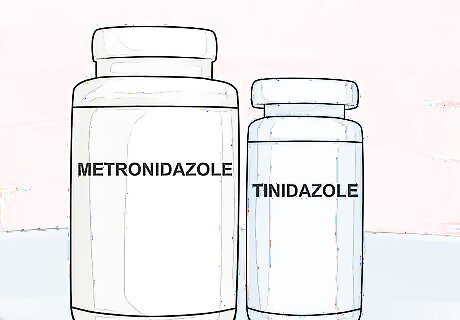
Get treatment. There are several prescription drugs that can be used to treat giardiasis, including metronidazole, tinidazole, and nitazoxanide. Different factors may affect how effective a drug regimen will be, including medical history, nutritional status, and the condition of your immune system. Infants and pregnant people may be more likely to experience dehydration from the diarrhea caused by giardiasis. To prevent dehydration, these at-risk populations should drink a lot of fluids while ill. Children should utilize an age appropriate electrolyte replacement fluid, such as Pedialyte. If you work with children or handle food, do not return to work until you're symptom-free for two days. The same goes for children in early childhood centers. Otherwise, you can go back to work as soon as you're symptom-free.
Understanding Giardiasis
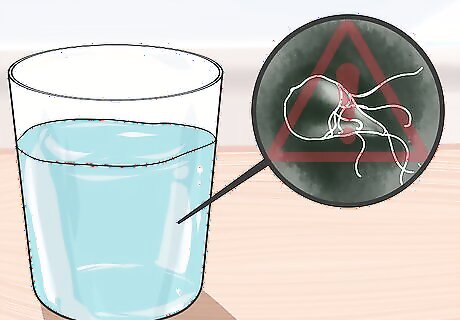
Understand how giardiasis occurs. Giardia is a microscopic parasite found on food, soil or in water that has been contaminated with feces from an infected human or animal. They are protected by an outer shell (called a cyst) that allows them to survive outside a host body for long periods and makes them tolerant of chlorine disinfectant. People are infected when they ingest the Giardia cyst. These cysts are infectious and swallowing as few as 10 can cause someone to become ill. An infected host may shed as many as one to 10 billion cysts daily in their stool for up to several months, particularly when untreated.

Know how giardiasis is transmitted. The parasites may be passed through contact with an infected object, food, or water. It can also be passed from animal to person and through oral-anal contact during sex. Giardia infection is most often waterborne. In other words, the parasite travels and is transported in water. These water supplies can be swimming pools, whirlpool spas, wells, streams and lakes, or municipal water supplies. Water infected by the parasite which is used to wash food, make ice or cook is also suspect. People at greatest risk of developing giardiasis include travelers to countries where it is common (namely, developing countries), people in childcare settings, people in close contact with someone who has the disease, backpackers or campers who drink water from lakes or rivers, and people who have contact with animals with the disease.

Learn about the long-term effects of a Giardia infection. In industrialized countries like the United States, giardiasis is almost never fatal. It can, however, cause lingering symptoms and some serious complications. Complications can include dehydration, failure to thrive, and lactose intolerance, among others. Dehydration can be a result of severe diarrhea. When the body doesn’t have enough water to carry out normal functions you can experience some significant problems. Complications of dehydration can include cerebral edema, or swelling of the brain, loss of consciousness, and kidney failure. If not treated immediately, severe dehydration can be fatal. Failure to thrive is a condition which occurs in children and the elderly or immunocompromised people. Malnutrition, as a result of poor absorption of nutrients and minerals due to the Giardia infection, can harm the development of a child’s physical and mental development. In the adults, it manifests as a state of decline, such as impaired physical or cognitive function. After giardiasis, some people suffer from lactose intolerance, the inability to appropriately digest milk sugar. Digestion of this milk sugar uses enzymes normally found in the intestinal tract. After this infection these enzymes may not be present and cause an intolerance to milk sugar after the infection has cleared. Other problems may include malabsorption, including vitamin deficiencies, severe weight loss, and debilitation.

Take preventive measures. Take the following measures to avoid becoming ill with giardiasis and also to avoid spreading the infection. Prevent infection: Do not drink untreated water or use ice made from untreated drinking water, especially in countries where the water supply might be contaminated. All raw vegetables and fruits should be washed with uncontaminated water and peeled before eating. Avoid eating uncooked foods when traveling in areas that may have unsafe water conditions. If your water comes from a well, have it tested. Testing of well water should be done frequently if the well is located in an area where animals graze. Avoid spreading infection: Avoid exposure to fecal matter. Use a condom or dental dam during oral or anal sex. Wash your hands thoroughly with soap and water after using the toilet, changing a diaper, or coming into contact with fecal matter. Do not swim in recreational waters, such as hot tubs, swimming pools, lakes, rivers, streams, or oceans if you have diarrhea. It is best to stay out of the water until at least two weeks after the diarrhea has ended.













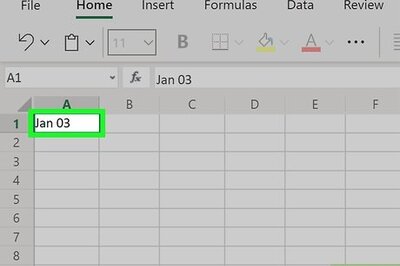





Comments
0 comment